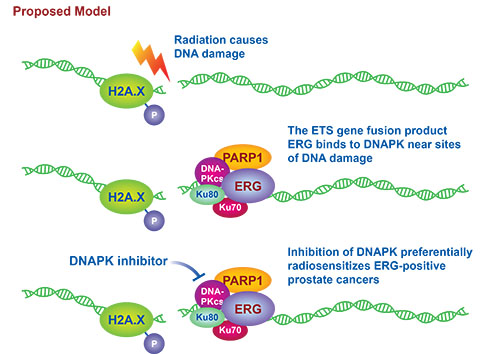


Posted June 8, 2015
Felix Feng, M.D., University of Michigan
 The ETS family represents 29 human genes, many of which have important implications in tissue development and cancer. ETS gene fusions, or hybrid genes formed from two previously separate genes, are present in approximately 50% of all prostate cancers and define a unique molecular subtype of this disease. To date, no strategies to target proteins produced from ETS fusion genes have entered into clinical practice. With support from a FY09 PCRP Physician Research Training Award, Dr. Felix Feng at the University of Michigan sought to investigate the role of ERG, a member of the ETS transcription factor family, in radiation therapy resistance and find potential therapeutic solutions.
The ETS family represents 29 human genes, many of which have important implications in tissue development and cancer. ETS gene fusions, or hybrid genes formed from two previously separate genes, are present in approximately 50% of all prostate cancers and define a unique molecular subtype of this disease. To date, no strategies to target proteins produced from ETS fusion genes have entered into clinical practice. With support from a FY09 PCRP Physician Research Training Award, Dr. Felix Feng at the University of Michigan sought to investigate the role of ERG, a member of the ETS transcription factor family, in radiation therapy resistance and find potential therapeutic solutions.
To determine the mechanism by which ERG mediates its effects, Dr. Feng identified all proteins that interact with ERG and found that DNA Dependent Protein Kinase (DNAPK) showed the strongest interaction. DNAPK is a critical component of the DNA double strand break repair pathway and could contribute to radiotherapy resistance by undoing the desired effects of radiation treatment. Based on this information, Dr. Feng performed experiments to investigate potential efficacy of DNAPK inhibition during radiation exposure. He found that by targeting DNAPK during radiation treatment, he was able to preferentially reverse ETS fusion-associated radio-resistance (Figure 1).
Clinical-grade DNAPK inhibitors have already been developed and are currently in phase I clinical trials for both solid and leukemic malignancies. Dr. Feng and his fellow investigators are hopeful that their experimental data will convince pharmaceutical companies to support phase II studies of these drugs in patients with prostate cancer. Their goal is to determine if these agents are preferentially effective in patients with prostate cancers harboring ETS fusions, and if proven correct, transition the drugs into clinical practice.
Dr. Feng's research project represents a multi-disciplinary collaboration which incorporates the strengths of radiation oncologists, pathologists, laboratory scientists, and medical oncologists. In drawing from a broad range of expertise, this project has the potential to eventually help translate an intriguing lab-based finding into a clinical trial which may improve outcomes for prostate cancer patients.
Dr. Feng credits the mentored PCRP Physician Research Training Award, which supported this project, with jumpstarting his career as a prostate cancer translational scientist.

Publications:
Links:














